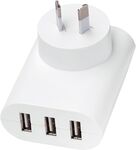Seems like good value for a 3 port charger with decent power output. I picked one up in store yesterday. Well designed and well made.
From their website:
3 USB ports
Equipped with auto-detect function ‒ the USB charger detects the connected device and adjusts the power output accordingly
Total output of 3.4A, 17W
Maximum output per USB port: 2.4A
Comes with built-in over-current protection, short-circuit protection and over-heating protection


3.4 over 3 ports isn't much